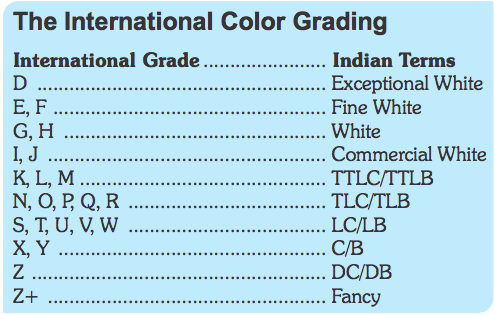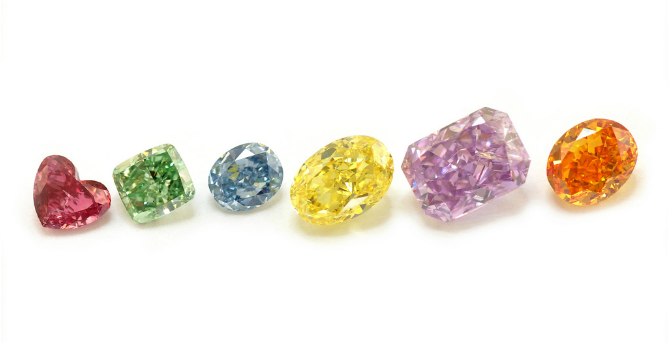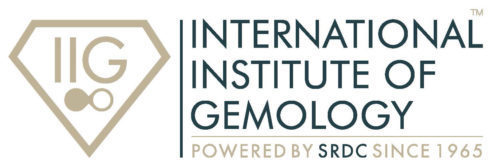The Color of Diamonds
Diamond in its pure form is colorless, but natural diamonds commonly display a range of colors. Transparent colors that affect the entire diamond are usually caused by the presence of atomic or molecular impurities and imperfections. Different body colors are linked to different impurities or imperfections, which form color centers. The body color of a diamond depends largely on the abundance of color centers and the size of the crystal. A large diamond will generally appear more intensely colored compared to a small diamond. Body colors are also influenced by the source of light. For example, diamonds in natural light may display a slightly different color than in artificial light. Diamonds with intense and attractive colors are often valuable gemstones, but very few diamonds belong to this group.
The Color grading standards
Understanding what diamond color means helps in choosing the right diamond. Interestingly, the diamond color evaluation of most gem-quality diamonds is based on the absence of color. A chemically pure and structurally perfect diamond has no hue, like a drop of pure water, and consequently, a higher value. GIA’s D-to-Z diamond color-grading system measures the degree of colorlessness by comparing a stone under controlled lighting and precise viewing conditions to masterstones of established color value.
The international color scale begins with D (colorless) continuing through Z (light yellow) according to the depth of the color saturation. Browns are graded on the same scale. Yellow or brown diamond with a body color deeper than Z are considered as fancy colors. It is important to remember that each letter on the scale represents a narrow range of color, not a specific point.
One of the most important factors in valuing diamonds is the color of the diamond. Diamonds are graded by the color using a letter from D to Z (Z + for fancy colors).
What happened to letters A through C?! Letters A through C were abandoned long ago because retailers were promoting their diamonds using phrases like “A quality!” without really teaching people about the 4 C’s of diamonds. There was no industry standard for people to compare stones. To eliminate the confusion, the Gemological Institute of America (GIA) formed the current standard beginning with D.
D, E and F are colorless, very rare and more expensive. G, H, I and J nearly colorless, but a trained jeweller can detect barely perceptible tint of color. This minor variations can be demonstrated by watching different color diamonds side-by-side.

International Color grades diamond by judging its body color in comparison with master stones certified by the international laboratories and then assigns the color grade ranging from colorless to light yellow or light brown.

Color Grading Procedure
1. Clean the diamond to be graded and also clean the masterstones. if necessary.
2. Grade the stone’s clarity and plot it so you can identify it later. Clean it again before color grading.
3. Use a dull, white background and daylight-equivalent light in a darkened room.
4. Set up masterstones left to right, lightest to darkest, about 1⁄2 inch apart.
5. Place the masterstones on the grading surface so you can look into their pavilions perpendicular to the pavilion facets.
6. Move the stone along the row of masterstones, comparing depth of color in the pavilions.
7. Keep the stone in the same position as the masterstone and as close as possible, but do not let them touch.
8. Compare the stone on both sides of each masterstone. When you find that it has more color than the masterstone on its left but less color than the masterstone on its right, give it the grade that matches the lighter masterstone.
9. Assign single-letter grades to grades D throug – N. Beyond that level you can assign double-letter grades in these increments: O-P, Q-R, S-T, U-V, W-X, and Y- Z.
10. Re-examine the stone to be sure you haven’t switched it with a masterstone. If you do accidentally make the switch, you can use the statistics on the masterstone’s grading report to re-identiy it and separate it from the stones you’re examining.
11. Some diamonds fluoresce, so when you check depth of color. you should also check fluorescence by exposing the diamond to longwave ultraviolet radiation. If you see fluorescence, record its color and state if it’s faint, medium, strong, or very strong. State “none” if the diamond doesn’t fluoresce.
Natural colored diamonds come in all shades and colors of the rainbow. The most popular colors and diamond types are a combination of pink, blue, brown, yellow, orange, green and red. Yellow is the most common naturally occurring color in a diamond.

Fancy Color Diamonds
A “fancy color diamond” is a natural colored diamond, found in a wide range of hues, including red, green, purple, violet, orange blue and pink. These diamonds are amongst the most rare and beautiful diamonds that nature has to offer. In fact, out of the approximately 80 000 carats of rough diamonds mined every year, only 0.001% are regarded as fancy colors.
The intensity grading system for fancy color diamonds differs than that of white diamonds. Unlike white diamonds, which range from the letter D-Z, fancy color diamonds are graded by nine different grades depend upon the intensity of color, The stronger the color – the higher the price. Color Grading standards for Fancy colors are as follows:
- Faint
- Very Light
- Light
- Fancy Light
- Fancy
- Fancy Intense
- Fancy Vivid
- Fancy Deep
- Fancy Dark
The darkest tone of a color with full saturation is usually called “Fancy Deep.” When Fancy Deep, These two are not preferable in fancy color range due to its dark tone, sometime even look blackish. The most expensive one will be Fancy Intense and Fancy Vivid. Check for catagorically mentioned “Even” in certificates, which means color is distributed evenly thoughout the diamond.

